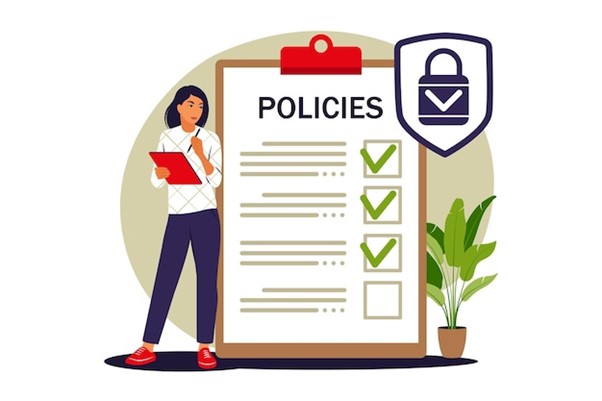Risk and Improvement
The Risks of Outdated Policies: What Your Organisation Needs to Know
In today’s fast-paced environment, staying effective means keeping every aspect of your operations up to date – especially your policies.
Outdated policies can lead to more than inefficiencies; they can result in significant financial, reputational, and operational risks. This is particularly important for any business and agency when resources are limited, and trust is paramount. Let’s explore the risks of outdated policies and why proactive policy management is essential for every organization.
Financial Risks: The Hidden Costs of Outdated Policies
One of the most immediate consequences of outdated policies is non-compliance with laws and regulations. Regulatory frameworks evolve regularly, and failure to keep policies aligned can result in:
- Hefty Fines and Penalties: Community and not-for-profit agencies are not immune to regulatory oversight. Non-compliance with laws such as health and safety regulations, privacy law, or employment standards can lead to fines and penalties that strain already tight budgets.
Example: In Aotearoa, failure to comply with employment law can lead to personal grievance action and ultimately to financial sanctions; non-compliance with the Health and Safety at Work Act 2015 can lead to fines of up to $600,000 for individuals or $3 million for organisations.
- Funding Risks: If you’re dependent on government or philanthropic funding, non-compliance or poor policy management can jeopardise funding agreements.
Example: Contracts with government agencies to provide services typically require compliance with regulatory standards like the Social Sector Accreditation Standards, Ngā Paerewa Health and Disability Service Standards. If you’re a business, iwi or community agency contracted to provide community housing, you must comply with the Performance Standards….. If you don’t keep your policies updated, this can lead to non-compliance with these standards and ultimately, result in loss of funding. t
- Increased Insurance Premiums: Non-compliance or repeated claims stemming from inadequate policies can raise insurance costs, which can be particularly burdensome for not-for-profits.
Reputational Risks: Outdated Policies Damage Trust
For all businesses and agencies, a good reputation is important. Outdated policies can jeopardise this and severely damage trust among stakeholders, current and potential clients, donors, and the public:
- Negative Publicity: A privacy breach or safety violation resulting from an outdated policy can lead to negative media coverage, harming your organisation’s credibility.
- Loss of Stakeholder Confidence: Funders, partners, whānau and community expect organisations and businesses want to deal with creditable and trustworthy organisations. Outdated policies can signal negligence and erode trust and confidence of staff and actual and potential clients, partners and funders.
- Impact on Volunteer Engagement: Community agencies often rely heavily on volunteers. However, volunteers may hesitate to support organisations with poor policy management, perceiving it as disorganized or unsafe.
Operational Risks: Efficiency Suffers Without Updated Policies
Outdated policies can hinder day-to-day operations, leading to inefficiencies and disruptions:
- Confusion Among Staff and Volunteers: Policies that are unclear or out of sync with current practices create confusion and inconsistent application.
- Delays in Decision-Making: Outdated policies may not address new challenges or scenarios, slowing decision-making processes. (See Good Decisions need Good Policies.)
- Increased Errors: When policies fail to reflect current best practices or technological advancements, errors are more likely, impacting service delivery.
The Benefits of Updating Policies
Keeping policies current isn’t just about avoiding risks; it’s about empowering your organisation and business to succeed. Updated policies:
- Enhance Compliance: Proactively address legal and regulatory requirements.
- Improve Efficiency: Provide clear guidance to employees and volunteers, reducing confusion and errors.
- Build Resilience: Prepare your organisation to adapt to changes and challenges effectively.
Best Ways to Manage These Risks
Effectively managing the risks associated with outdated policies requires a proactive and systematic approach. Here are some best practices:
- Schedule Regular Policy Reviews: Set a timeline to review each policy, typically annually or whenever major regulatory updates occur.
- Leverage Technology: Join The Policy Place online policy service for policies that support your compliance and are regularly reviewed and updated for legal and other regulatory changes. With your policies taken care of, you can focus on policy implementation (Check out the benefits here.).
- Engage Diverse Stakeholders: Gather and include input and feedback from your stakeholders like clients, kaimahi/staff and community partners when updating your policies and seek out cultural and industry expertise in areas it is needed.
- Provide Ongoing Training: Ensure all your kaimahi and volunteers are trained and have a good understanding of your policies and how to access them. You can’t rely on your policies and procedures with staff and expect compliance if they don’t know about them!
- Conduct Audits: Arrange for checks and audits of case files and other documentation to ensure that policies are complied with. Where there is non-compliance, address it and strategise to prevent recurrence.
- Document and Communicate Updates: Clearly document any changes to policies and communicate them effectively across your organisation to avoid confusion. As a member of The Policy Place we keep your policies updated and keep you informed about updates.
How We Can Help with Policy Management
At The Policy Place we specialise in keeping your policies compliant, relevant, and effective. Our services include:
- Policy Development: We provide core policy content to support agencies to comply with the law and other regulations and to meet good sector and industry practice.
- Policy Monitoring & Review: We ensure that clients keep up with legislative and other regulatory changes.
- Comprehensive Policy Audits: Identify gaps and areas for improvement.
Whether you’re a business, a not-for-profit or other organisation, don’t let outdated policies hold you back. Contact us today to learn how we can help you minimize risks and maximize operational success.
How Organisational Policies can Promote and Protect Rights
In an increasingly complex world, the protection and promotion of human rights are more essential than ever. With political landscapes shifting toward conservatism in many countries, including Aotearoa/New Zealand, the rights of minorities are often left vulnerable.
But there is good news: organisations, whether they are businesses, or non-profits, have the power to champion human rights within their spheres of influence.
A practical and impactful way to achieve this is through organisational policies and procedures.
Why Organisational Policies Matter for Human Rights
Policies and procedures serve as the backbone of an organisation. They set expectations, guide behaviour, and establish accountability. More importantly, they reflect the values of an organisation. By embedding human rights principles into policies, organisations can:
- Foster Inclusive Workplaces: Policies that promote diversity, equity, and inclusion (DEI) and support the implementation of Te Tiriti o Waitangi help ensure that everyone feels valued and respected, regardless of their background. (For more, see our previous posts on the value of Treaty-based policies) and Cultural Responsiveness.
- Mitigate Discrimination and Harassment: Clear anti-discrimination and anti-harassment policies create safer spaces for kaimahi/employees, clients, and stakeholders.
- Influence Industry Standards: Organisations that model best practices can inspire others to follow suit, amplifying their impact.
Steps to Integrate Human Rights into Policies and Procedures
To transform organisational policies into tools for protecting and promoting human rights, here are some actionable steps:
- Conduct a Human Rights Audit: Evaluate existing policies and procedures to identify gaps or areas where human rights principles can be strengthened.
- For example, assess recruitment policies to ensure they actively address barriers faced by underrepresented groups.
- Integrate Human Rights in Core Policies: Incorporate explicit commitments to human rights into key organisational documents, such as:
- Codes of Conduct: Outline expectations for respectful and inclusive behaviour.
- Supplier Agreements: Require suppliers to adhere to ethical practices and environmental standards.
- Whistleblower Policies: Ensure kaimahi/employees can report rights violations without fear of reprisal.
- Provide Ongoing Education: Equip kaimahi/staff with the knowledge and tools to uphold human rights in their daily roles. Training sessions on unconscious bias, cultural competency, and ethical decision-making can build awareness and skills.
- Engage in Advocacy: Organisations can use their platforms to advocate for human rights externally. For instance, a business could publicly support policies that advance Indigenous rights or LGBTQ+ inclusion.
- Monitor and Adapt: Regularly review and update policies to respond to evolving societal needs. Engage with stakeholders, including employees and community representatives, to ensure policies remain relevant and effective.
Examples of Organisations Championing Human Rights Through Policies
Many organisations are already leading the way in promoting human rights through their policies:
- Social, Health and Community Services: Across Aotearoa, New Zealand, many organisations have policies and strategies to prioritise equitable access to services, ensuring no one is left behind.
- Local Authority policies for inclusive public transport to ensure accessibility for people with disabilities (eg Auckland Transport DEI policy)
- The Policy Place: We are proud to provide human rights-focused policies for diverse organisations that reflect our commitment to human rights. Our work includes supporting agencies with online policies addressing Te Tiriti o Waitangi, Cultural Responsiveness, and Diversity and Inclusion, ensuring that these principles are not only acknowledged but actively upheld.
The Ripple Effect of Human Rights Policies
When organisations commit to protecting human rights, they contribute to a ripple effect that extends far beyond their walls. Kaimahi/employees bring inclusive practices into their personal lives. Clients and customers are inspired by ethical leadership. And industries begin to view human rights as essential, not optional.
In a time when governments may falter in safeguarding rights, organisations have the opportunity to step up and lead. By leveraging policies and procedures as tools for change, they can create environments where everyone—regardless of race, gender, ability, or background—can thrive.
Call to Action
Whether you’re a business owner, a manager, or a team member, consider the role your organisation plays in promoting human rights. Take a closer look at your policies. Do they reflect your values? Are they making a tangible difference? If not, it’s time to take action.
The future of human rights doesn’t just depend on governments. It depends on all of us. Together, we can build organisations—and societies—that are fairer, safer, and more inclusive for everyone.
Top Compliance Risks for Businesses in 2025 and How to Address Them
In today’s fast-changing technological and regulatory environments, compliance risks for businesses are significant. Businesses face increasing scrutiny from regulators, customers, and other stakeholders to meet legal obligations and uphold best practices. As 2025 unfolds, here are the top compliance risks businesses need to be aware of—and strategies to address them effectively.
1. Data Privacy and Cybersecurity
With the growing prevalence of data breaches and stricter privacy laws, data protection strategies are non-negotiable for all businesses. Laws like the Privacy Act 2020 and global regulations such as the GDPR are evolving, placing higher demands on businesses to safeguard customer and employee data.
How to Address It:
- Conduct regular audits of your data handling processes.
- Implement robust cybersecurity measures, such as encryption and multi-factor authentication.
- Provide training for staff/kaimahi on data privacy and security protocols.
- Ensure your policies reflect the latest regulatory requirements and technological advancements.
2. Workplace Health and Safety Compliance
Health and safety remain top priorities, with regulators closely monitoring workplace standards. This includes ensuring compliance with the Health and Safety at Work Act 2015, particularly for higher-risk industries. Our Health and Safety regulatory system including the Health and Safety Act is currently being reviewed. The review may result in changes affecting your policies and processes.
How to Address It:
- Regularly review and update your health and safety policies and processes.
- Engage kaimahi/staff in health and safety training and drills.
- Stay informed about the Health and Safety Review and industry-specific guidelines and best practices.
3. Environmental, Social, and Governance (ESG) Obligations
ESG compliance is no longer optional. Stakeholders demand transparency about how businesses impact the environment and society and stakeholder accountability. We all play a vital part in reducing emissions, waste management, and sustainable practices and organisations across every sector have responsibilities.
How to Address It:
- Create or update your ESG policies to align with current regulations and industry standards.
- Prevent harm to current and future generations
- Recognise that business assets and profitability rest, in the long run, on environment, social and cultural respect.
- Monitor your environmental impact and sustainable practice.
- Communicate ESG efforts to stakeholders, showcasing accountability and progress.
4. Anti-Money Laundering and Countering Financing of Terrorism
Financial regulations require businesses to identify and mitigate risks related to money laundering and terrorism financing. Non-compliance can lead to severe penalties and reputational damage.
How to Address It:
- Ensure your policies comply with the Anti-Money Laundering and Countering Financing of Terrorism Act 2009.
- Implement robust customer due diligence processes.
- Train kaimahi/staff on identifying suspicious activity and reporting obligations.
5. Employment Law Compliance
Employment law violations, such as failing to meet wage and holiday requirements or mishandling workplace disputes, can result in costly penalties and harm to workplace morale. Recent and proposed changes in Aotearoa to employment law relating to employment status, the minimum wage and personal grievances highlight the importance of staying current.
How to Address It:
- Review workplace policies regularly and employment agreements to ensure agreements align.
- Ensure all your kaimahi/staff are familiar with your policies and procedures and kept informed about changes.
- Provide training to all management levels on fair treatment and dispute resolution.
- Monitor updates to employment legislation and ensure your policies are kept current.
6. Consumer Protection and Marketing Compliance
Misleading advertising, false claims, or breaches of the Fair Trading Act 1986 and the Consumer Guarantees Act 1993 can lead to legal action and loss of consumer trust.
How to Address It:
- Ensure marketing materials comply with advertising standards and consumer laws.
- Train staff on ethical sales practices and accurate representation of products or services.
- Monitor feedback channels to identify and address consumer complaints promptly.
How We Can Help
Keeping up with regulatory changes can be overwhelming, but you don’t have to do it alone. Our policy management service takes the guesswork out of compliance. We provide:
- Policy content updated to reflect the latest laws and standards.
- Tools to track staff awareness and adherence to policies.
- Regular policy reviews to ensure your business remains compliant.
By outsourcing your policy management, you save time, reduce risks, and gain peace of mind knowing your policies are always current and compliant.
Final Thoughts
Compliance risks are an ever-present challenge for businesses, but they’re manageable with the right approach. By staying proactive and partnering with experts, you can protect your business, maintain trust, and focus on growth in 2025 and beyond.
Contact us today to learn how we can support your compliance needs!
Aligning with Family Violence Standards: Policy Reviews
At The Policy Place, we are committed to regularly reviewing and updating our online policies to ensure they meet the highest standards and reflect the latest developments in the field. Our next review will focus on policies related to abuse, child protection, and safeguarding vulnerable adults.
These policies are crucial for compliance with the Social Sector Accreditation Standards, Health and Disability Standards, and legislation such as the Children’s Act 2014.
Our Review Process
When we review and update our online policies, we take into account feedback from our members, as well as current laws, regulations, and best practice codes. This comprehensive approach ensures that our policies are not only compliant but also practical and effective for our diverse membership.
In the upcoming review, we will be incorporating two significant developments: the Specialist Family Violence Organisation Standards and the Recommendations of the Royal Commission on Abuse in Care. These updates are essential to ensure our policies remain relevant and effective in addressing the needs of those we serve.
The Importance of Specialist Family Violence Organisation Standards
The Specialist Family Violence Organisation Standards (“the Standards”) are a set of comprehensive guidelines developed as part of Te Aorerekura: The National Strategy to Eliminate Family Violence and Sexual Violence. These standards aim to guide consistent and high-quality practice among organizations providing services to individuals affected by family and sexual violence.
Key Features of the Standards
The Standards reflect extensive collaboration and insights from professionals in the family violence and sexual violence sectors, tangata whenua, community representatives, agencies, and victim-survivors. For organisations like ours, they provide a valuable framework for revising and updating policies and procedures. Key criteria include:
- Recognition of various forms of family violence: Including child abuse, elder abuse, and sexual violence, and the differing impacts based on cultural, gender, and care dynamics.
- Ensuring safety and autonomy for victim-survivors: Entailing provision for direct and indirect service users and for the safety and wellbeing of tamariki even when children are not direct service users.
- Victim and whānau-centered risk assessment and safety planning: Conducted in a culturally responsive manner and reflecting knowledge of family-violence related risk factors (eg separation, pregnancy).
- Supporting a trauma and violence-informed approach: a focus on the impact of violence (distinct from other causes of trauma) on individuals and communities and recognising interconnected experiences of interpersonal and systemic violence.
- Reflecting a ‘primary victim-survivor, predominant perpetrator’ analysis: – Reflected in policies and procedures around risk assessment, planning and service delivery.
- Recognising and addressing the rights and interests of deaf and disabled individuals and adults needing safeguarding – addressing the contexts of care and impacts of stigma and misinformation.
- Promoting culturally safe and appropriate practices: – Recognising intersectionalities and impacts for people of diverse genders, ethnicity and abilities.
How The Standards Apply
The Standards are vital for organisations providing specialist family violence responses but can also be utilised by any organization wanting to enhance their response capabilities and organisational practices. They complement existing accreditation and practice frameworks from agencies like the Ministry of Justice, Te Kāhui Kahu and the Ministry of Social Development.
The Policy Place Abuse and Protection policies are already aligned with many aspects of the Standards, such as cultural responsiveness, safety planning, and legislative references.
However, we strive to do more. Through review and updating, Policy Place members operating in social service, health, disability and justice sectors will have their policies more specifically aligned to the Standards. Members will therefore gain the assurance that their policies:
- Comply with legal and regulatory requirements: And reflect best practices.
- Are endorsed and utilised by different sectors: And comply with different accreditation criteria
- Guide the delivery of safe, inclusive, and responsive services: To diverse communities.
This helps build support national consistency in the application of the Standards because, as a leading provider of policies and procedures for agencies in NZ, our reviews and updates positively impact many organisations in Aotearoa. Nationwide, we are helping build a safer and more effective network of services and supports for those impacted by family and sexual violence.
Conclusion
Regularly reviewing and updating our policies is not just about compliance; it’s about ensuring that our members are equipped with the best tools and practices to provide safe, effective, and inclusive services. By aligning with the Specialist Family Violence Organisation Standards and incorporating feedback and new developments, we can support our members in delivering high-quality care and protection to those who need it most. Together, we can make a significant impact in the fight against family and sexual violence.
New- Policy Tracking and Reporting for Compliance and Efficiency Gains
We’ve just introduced Policy Tracking and Reporting for members of the Police Place’s online policy service.
This new function provides managers with valuable information about the views and use of organisational policies and procedures. It also offers evidence of compliance that organizations can use for audits and assessments, ensuring adherence to the Social Sector Accreditation Standards, Ngā Paerewa Health and Disability Standards and other relevant laws and regulations.
In this post, we’ll cover what Policy Tracking involves, its benefits and how to impelement and use this new function.
If you are a member of the online policy service let us know if you want access to the new function. If you are not yet a member, contact us NOW to discuss joining.
What is Policy Tracking
Policy Tracking reports on the use and views of an organisation’s policies. It tells you which of your policies have been viewed and by whom, within chosen timeframes.
Here’s an example of a Policy Report:

- The report can be specific to a staff member or group of staff.
- It can be specific to policy pages.
- It can consider policy views within your chosen timeframe. .
The Benefits
We added this function because clients were asking for it. Policy Tracking and Reporting will bring the following benefits:
- Enhanced Compliance: Policy tracking provides records of policy views that can be used to evidence compliance with policies and laws during audits and inspections. This transparency can protect an organisation from liability and shows a proactive approach to compliance.
- Risk Management: Ensuring that all staff have viewed and understood critical policies like the Code of Conduct, Health and Safety, and Complaints reduces the risk of non-compliance with laws and regulations and harmful consequences.
- Operational Efficiency: By automating the tracking of policy views, organisations can save time and resources that would otherwise be spent manually monitoring compliance.
- Improved Transparency and Responsibility: Policies should be a single source of truth for an organisation. Policy Tracking reminds staff of the need to keep themselves informed about revisions and updates to policies and helps steer organisational members in the same direction.
- Continuous Improvement: Policy Tracking will provide information that can help investigate workplace incidents or complaints and plan training and service improvements.
Beware of privacy implications

Policy Tracking involves handling staff personal information, so applying privacy safeguards is crucial:
- Inform Staff: Before implementing the Policy Tracking function, let staff know you are going to do it and the purpose behind it.
- Anonymise Data: When using the Tracking data for audit and assessment purposes, remove identifying information. Anonymised and aggregated data provides as good evidence of policy use as identifying data.
- Restrict Access: Only allow authorised personnel to access Tracking data to ensure personal information remains secure. Usually, access will be confined to management.
- Limit Data Use: Tracking data must not be used for any purpose unrelated to the reason it is gathered unless allowed by law.
- Transparency: Inform staff they can request access to the tracking data you collect about their access and use of policies.
Limitations of Policy Tracking
We’ve previously posted about the limitations of a compliance-focused approach to policy. The limitations apply to the new Policy Tracking function.
While policy tracking tells you if a person has looked at a policy, it does not tell you whether they understood the policy or whether the policy has been applied. That’s where our online courses come in. Check them out here. They are short online courses that support members and non-members of the online policy service in understanding and applying policies and procedures in a range of areas.
Conclusion
The new service for tracking staff views of policies and procedures promises many benefits for our online policy members. It will support our policy clients in building service quality and efficiency, reducing risk, and fostering a culture of transparency and responsibility.
If you want to use the Policy Tracking function and you’re one of our online policy service members, then just let us know. If you’re not an online policy service member but are interested in joining, contact us to discuss your policy needs and how we can assist.
Contact us NOW to enhance your compliance and operational efficiency with our new Policy Tracking and Reporting service.
Fostering Organisational Justice: Strategies for Workplace Fairness and Wellbeing
Why You Need a Comprehensive AI Policy
Artificial intelligence (AI) is becoming integral to many industries in Aotearoa, including social and health services. While AI offers benefits, it also poses significant risks that need to be addressed through comprehensive AI policies. That’s why we at the Policy Place have recently released our new AI policy for our online policy clients.
In this blog we consider the importance of having an AI policy in social and health service agencies, the risks of not having a policy and some of the key things to cover in an AI policy for community, social and health services. For our previous post on AI use in social and health services see here.
The Rise of AI in Workplaces
Artificial intelligence is no longer a futuristic concept; it is actively shaping how organisations operate.
The 2024 Work Trend Index Annual Report from Microsoft and LinkedIn released in May this year, found that AI is prevalent in the workplace worldwide. Key findings highlighted that AI use is pervasive in global workplaces and that AI use is beneficial in terms of time-saving, efficiency gains and adding to the enjoyment of work.
However, the Report also identified pervasive risk with AI use; that, in workplaces without an AI policy or other guidance 78% of employees had taken things into their own hands and were bringing and using their own AI tools at work.
The Risks of AI Use without AI policies and guidance include:
- Data Security Risks: AI systems can be vulnerable to cyber-attacks, which can lead to data breaches and loss of sensitive information. Without an AI policy, staff may input personal information and sensitive organisational data.
- Ethical and Legal Risks: AI use can lead to ethical dilemmas and legal issues, such as unauthorised use of personal data, breach of copyright and AI-driven decisions that are biased and breach human rights.
- Operational Risks: Relying on AI without proper oversight can lead to operational inefficiencies, errors, and potential harm to clients.
- Cultural Risks: AI data may not be sufficiently responsive to diverse cultural contexts and needs of different communities. Without proper AI policies and guidance, AI use risks undermining important cultural practices and values, particularly those protected by Te Tiriti o Waitangi.
The Importance of an AI Policy
An AI policy is basically the starter or minimum for a workplace to address some of these risks:
- Ensuring Ethical Use of AI: An AI policy helps ensure that AI tools are used ethically and responsibly. This is crucial in social, community and health services, where decisions made by AI can significantly impact individuals’ lives and well-being.
- Protecting Client Privacy: An AI policy guides how staff should use AI in alignment with the Privacy Act 2020 and privacy policies. This is particularly important for social, health and community services dealing with highly sensitive and confidential data.
- Maintaining Accountability: Clear guidelines within an AI policy guide staff on how they may use AI in their decisions and their duty of reasonable care. This is particularly important in health and social services, where transparency and trust are paramount.
- Preventing Discrimination: An AI policy will include checks that staff must do on AI generated data before relying on it and prohibitions against reliance on unbiased and unverified data.
- Honoring Te Tiriti o Waitangi: AI policies must recognise and protect Treaty of Waitangi rights. This includes ensuring that AI use does not disadvantage iwi and whānau Māori that health and community services work with and that data sovereignty and cultural considerations are respected.
Strategies to support an AI Policy
An AI policy is just the beginning for a workplace wanting to use AI. Like any policy, your AI policy needs to be backed up by a strong implementation strategy that includes the following
- Regular Audits and Assessments: Conduct regular audits of AI systems to ensure they operate as intended and comply with ethical standards.
- Training and Awareness: Provide training for staff on the responsible use of AI and raising awareness about potential risks and ethical considerations.
- Bias Mitigation Strategies: Implement strategies to identify and reduce biases in AI systems eg data checking, surveys and if affordable, bias detection algorithms.
- Robust Security Measures: Apply strong cybersecurity protocols to protect AI systems from threats and ensure the integrity of data.
- Transparent Decision-Making: Ensure through training and policy that staff responsibilities for AI use are clearly articulated, and AI-driven decisions are transparent and explainable.
- Cultural Safety and the Treaty: Use strategies like training, bias detection systems and iwi/community consultation to ensure that the rights of tangata whenua under the Te Tiriti o Waitangi are respected and protected with AI use.
Conclusion
AI brings benefits as well as risks especially for the social, community and health services we work with. To get the most out of AI and help protect against the risks, an AI policy is a “must.” It’s arguably the beginning of a new policy era when, in response to rapidly evolving technology, we need to revise and evolve policies at an equally fast pace.
Learning v Compliance Reporting and Tracking
In organisations of many types, compliance reporting and tracking have led to a compliance-driven approach to operations.
However, a paradigm shift is now underway in the not-for-profit sector. Having long struggled to get staff on board with compliance and policy implementation, many nonprofit agencies are shifting from a compliance-driven approach to a learning-focused one.
In this blog, we’ll explore why a learning approach to compliance is superior to compliance tracking and reporting for an organisation that is required to meet regulations and standards like the Social Sector Accreditation Standards, Community Housing Performance Standards and Ngā Paerewa Health and Disability Service Standards.

1. Fosters a Culture of Continuous Improvement
Unlike compliance reporting, which often focuses solely on meeting minimum requirements and is backward looking, a learning approach to compliance encourages ongoing growth and development. By prioritising learning, agencies can foster a culture of continuous improvement, where kaimahi/staff members are empowered to seek out new knowledge, skills, and best practices.
2. Learning approach aligns with non-profit kaupapa
Nonprofit agencies typically have a person/whānau centred kaupapa and value the concept of voluntariness highly. A learning approach to compliance aligns with this, particularly, these short online courses developed specifically for non-profit agencies in Aotearoa. The learning approach to compliance assumes that most people want to meet their obligations. It allows the broadest possible compliance at the least cost both to the agency and to the individual.

3. Compliance reporting and tracking
Agencies accept these as a necessary evil. But compliance reporting and tracking can incentivise fast tracking and a tick-box mentality in an organisation. This can ultimately undermine an organisation’s capacity to improve and build quality of service and reduce staff motivation to innovate and “go outside of the box.” Check out our previous blog about the disadvantages.

4. Drives Innovation and Creativity
Compliance reporting tends to focus on maintaining the status quo—ensuring that existing processes and procedures meet regulatory standards. In contrast, a learning program encourages staff members to think outside the box, explore new ideas, and experiment with innovative approaches. This is facilitated by interactive content like scenarios and quizzes in the Policy Place’s online courses.

5. Supports Engagement and Retention of Kaimahi
Research consistently shows that organisations that invest in employee learning and development experience higher levels of engagement and retention. A learning approach to compliance demonstrates to kaimahi that their growth and professional development are valued as much as the organisation values compliance with external standards. This contributes to greater job satisfaction and loyalty and to an organisation’s ability to retain and attract quality staff.

6. Builds skills and ability to comply
Interactive elements and engagement in online courses can help reinforce key concepts and information retention about requirements for compliance. They provide real-world examples and practical scenarios to illustrate how policy content is applied in different contexts.
This practical application helps staff understand the relevance of policy content and how it translates into everyday practices and decision-making. Ultimately, it means that staff are better prepared for and empowered to meet their obligations.
Conclusion
While compliance reporting serves an important function in ensuring accountability and regulatory adherence, its limitations are increasingly apparent in the nonprofit sector. By embracing a learning-focused approach, nonprofit agencies can unlock a wealth of benefits—from fostering a culture of continuous improvement to driving innovation and creativity.
Ultimately, investing in learning programs isn’t just about checking boxes; it’s about empowering staff, enhancing organisational resilience, and advancing the kaupapa of human service agencies.
RiskManagement with the help of good policies and procedures
Risk management is a key reason for policies and procedures – risks like financial mismanagement, accidents, cyberthreats, privacy.
Take a broad view. No need to be afraid of risk. The wider your view of risk the better prepared you can be and the more able and confident you can feel in your business/organisation.
While risks will be unique to your operation, there are also risks that all of us in business need to manage. At the Policy Place, we help organisations manage these risks with online policies that are regularly reviewed and updated and with other strategies like guidelines and checklists.
Some of the common risks for organisations are listed below, with some of the more common policies and strategies to help manage these risks:
Financial Risk Management
- Policy and procedures relating to financial planning and controls
- Fraud and Corruption policy
- Protected Disclosures policy
- Financial Planning and Investment policies
Information Risk Management
- Preventative & Troubleshooting Maintenance Contracts
- Privacy and Confidentiality policy
- Record Management and Archiving system
- Privacy Breach Procedure
- Information Safeguards policy and procedure
Managing Economic & Political Risks
- Media-related policies and processes
- Hazard-management policy and procedure
- Staff and Governance Recruitment Policies and Procedures
- Strategic & Business Planning
- Hazard & Risk Register
Health and Safety Risk Management
- Wellbeing policy and procedure
- Health and Safety procedures including Hazard and Risk Register; Staff Participation
- Induction and ongoing staff training
- Pandemic Planning
- Infection Control policy and procedures
- Cultural Safety and Responsiveness policy and training
- Harassment and Bullying policy and procedure
Service-related Risk Management
- Complaints and Feedback Policy and Procedures
- Performance and service planning and review processes
- Quality Management policy and procedure
- Training and development of staff
- Policies to guide delivery
- Business Continuity Plan
Risky business – when offending hits the workplace
The case of Philip Barnes was recently laid bare in New Zealand media when his name suppression order was lifted. It’s a good reminder about what not to do when, as a manager, you learn that a staff member may have been involved in offending.
The case
In 2017, International Accreditation New Zealand (IANZ) management learned that Barnes (a General Manager) was involved in a Police investigation of spying in a gym changing room. Police uplifted Barnes’ computer from IANZ and returned it a few days later.
In June 2018, Barnes pleaded guilty to making an intimate visual recording. He sought and got name suppression. In 2020, he was discharged without conviction and granted permanent name suppression. Both orders were successfully appealed by Police and recently, the name suppression order was lifted.
While Barnes was being investigated by Police, IANZ conducted an investigation. A minimal investigation. They questioned Barnes and accepted his assurances that he was involved, basically, as “someone in the wrong place at the wrong time.”
3 lessons
Don’t turn a blind eye
In this case, offending occurred outside work. Even so, as a manager, you can’t assume that the offending will not impact on the business.
An employee’s conduct outside of work may bring an agency into disrepute. This was clearly a risk for IANZ.
Turning a blind eye, by accepting Barnes’ explanation for the Police investigation without checking objective facts, exposed IANZ to significant risk.
Even if offending is alleged to have occurred outside work, as a manager, it’s important that you make reasonable inquires to apprise yourself of the facts.
You don’t have to duplicate the Police investigation. It’s important not to interfere with it.
But it is important that you make sufficient inquiry to fully understand the nature and possible consequences of the allegation(s) to your staff, organisation and client base.
Don’t assume innocence or guilt
We all want to believe the best of people, particularly of staff who we work beside each day and we know to be hardworking. Conversely, we may be more inclined to think a staff member is guilty if we don’t like them.
Either way, hold off. Resist any such assumption.
Your best bet is to be as dispassionate as possible about the allegation(s), while being compassionate and fair to the staff member concerned and any affected staff or others. This will enable you to undertake a reasonable and balanced inquiry into the nature of the allegation(s) and scope the risks associated with them.
Assess and manage risk
The major omissions in the IANZ/Barnes case were the failure to make a reasonable inquiry into the Police investigation. Secondly, IANZ failed to fully scope, assess and manage risks, including risk to its reputation as an agency that’s all about upholding standards.
Risk assessment and management are key tasks for management when confronted with alleged offending by an employee.
Risks to the victim(s), staff member, clients, colleagues, and to the reputation of the agency must all be assessed.
Mitigations established as necessary. They might involve suspension, a change of duties, extra supervision, change of workplace or work hours, etc – depending on the situation, level and nature of risk(s). Mitigations need to be worked out with the employee concerned and their effectiveness monitored and adjusted accordingly.
So…
Learn from what IANZ didn’t do.
Review your policies and procedures to make sure they guide you and your staff to respond if staff become involved in a Police investigation.
At the Policy Place we’ve got you covered if you’re a member of our online policy service. Risk management is an important feature of our online policies eg policies on Background and Child Safety Checking, Quality Assurance, Service delivery and Health and Safety.
If you want to know you’re covered with good policies that are reviewed and kept up-to-date contact us to join the online policy service or book a free consultation to talk about your needs.








